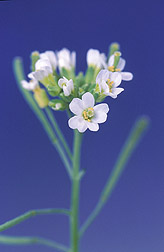This page has been archived and is being provided for reference purposes only. The page is no longer being updated, and therefore, links on the page may be invalid.
"Junk" DNA Proves to be Highly Valuable
By Alfredo FloresJune 2, 2009
What was once thought of as DNA with zero value in plants--dubbed "junk" DNA--may turn out to be key in helping scientists improve the control of gene expression in transgenic crops.
That's according to Agricultural Research Service (ARS) plant pathologist Bret Cooper at the agency's Soybean Genomics and Improvement Laboratory in Beltsville, Md., and collaborators at Johns Hopkins University in Baltimore, Md.
For more than 30 years, scientists have been perplexed by the workings of intergenic DNA, which is located between genes. Scientists have since found that, among other functions, some intergenic DNA plays a physical role in protecting and linking chromosomes. But after subtracting intergenic DNA, there was still leftover or "junk" DNA which seemed to have no purpose.
Cooper and collaborators investigated "junk" DNA in the model plant Arabidopsis thaliana, using a computer program to find short segments of DNA that appeared as molecular patterns. When comparing these patterns to genes, Cooper's team found that 50 percent of the genes had the exact same sequences as the molecular patterns. This discovery showed a sequence pattern link between "junk" and coding DNA. These linked patterns are called pyknons, which Cooper and his team believe might be evidence of something important that drives genome expansion in plants.
The researchers found that pyknons are also the same in sequence and size as small segments of RNA that regulate gene expression through a method known as gene silencing. This evidence suggests that these RNA segments are converted back into DNA and are integrated into the intergenic space. Over time, these sequences repeatedly accumulate. Prior to this discovery, pyknons were only known to exist in the human genome. Thus, this discovery in plants illustrates that the link between coding DNA and junk DNA crosses higher orders of biology and suggests a universal genetic mechanism at play that is not yet fully understood.
The data suggest that scientists might be able to use this information to determine which genes are regulated by gene silencing, and that there may be some application for the improvement of transgenic plants by using the pyknon information.
This research was published online as an advance article on the Molecular BioSystems website, and will be published later this year in a special issue of Computational Systems Biology.
ARS is the principal intramural scientific research agency of the U.S. Department of Agriculture.

